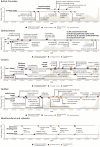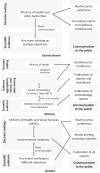Canada's provincial COVID-19 pandemic modelling efforts: A review of mathematical models and their impacts on the responses
- PMID: 39060710
- PMCID: PMC11382646
- DOI: 10.17269/s41997-024-00910-9
Canada's provincial COVID-19 pandemic modelling efforts: A review of mathematical models and their impacts on the responses
Abstract
Setting: Mathematical modelling played an important role in the public health response to COVID-19 in Canada. Variability in epidemic trajectories, modelling approaches, and data infrastructure across provinces provides a unique opportunity to understand the factors that shaped modelling strategies.
Intervention: Provinces implemented stringent pandemic interventions to mitigate SARS-CoV-2 transmission, considering evidence from epidemic models. This study aimed to summarize provincial COVID-19 modelling efforts. We identified modelling teams working with provincial decision-makers, through referrals and membership in Canadian modelling networks. Information on models, data sources, and knowledge translation were abstracted using standardized instruments.
Outcomes: We obtained information from six provinces. For provinces with sustained community transmission, initial modelling efforts focused on projecting epidemic trajectories and healthcare demands, and evaluating impacts of proposed interventions. In provinces with low community transmission, models emphasized quantifying importation risks. Most of the models were compartmental and deterministic, with projection horizons of a few weeks. Models were updated regularly or replaced by new ones, adapting to changing local epidemic dynamics, pathogen characteristics, vaccines, and requests from public health. Surveillance datasets for cases, hospitalizations and deaths, and serological studies were the main data sources for model calibration. Access to data for modelling and the structure for knowledge translation differed markedly between provinces.
Implication: Provincial modelling efforts during the COVID-19 pandemic were tailored to local contexts and modulated by available resources. Strengthening Canadian modelling capacity, developing and sustaining collaborations between modellers and governments, and ensuring earlier access to linked and timely surveillance data could help improve pandemic preparedness.
RéSUMé: CONTEXTE: La modélisation mathématique a joué un rôle de premier plan dans les ripostes sanitaires à la COVID-19 au Canada. Les différentes trajectoires épidémiques provinciales, leurs approches de modélisation et infrastructures de données représentent une occasion unique de comprendre les facteurs qui ont influencé les stratégies de modélisation provinciales. INTERVENTION: Les provinces ont mis en place des mesures de santé publique strictes afin d’atténuer la transmission du SRAS-CoV-2 en tenant compte des données probantes provenant des modèles épidémiques. Notre étude vise à décrire et résumer les efforts provinciaux de modélisation de la COVID-19. Nous avons identifié les équipes de modélisation travaillant avec les décideurs provinciaux parmi les réseaux Canadiens de modélisation et par référence. Les informations sur les modèles, leurs sources de données et les approches de mobilisation des connaissances ont été obtenues à l’aide d’instruments standardisés. RéSULTATS: Nous avons colligé les informations provenant de six provinces. Pour les provinces qui ont eu de la transmission communautaire soutenue, les efforts de modélisation initiaux se sont concentrés sur la projection des trajectoires épidémiques et des demandes de soins de santé et sur l’évaluation des impacts des interventions proposées. Dans les provinces où la transmission communautaire a été faible, les modèles visaient à quantifier les risques d’importation. La plupart des équipes ont développé des modèles à compartiments déterministes avec des horizons de projection de quelques semaines. Les modèles ont été régulièrement mis à jour ou remplacés par de nouveaux, s’adaptant aux dynamiques locales, à l’arrivée de nouveaux variants, aux vaccins et aux demandes des autorités de santé publique. Les données de surveillance des cas, des hospitalisations et des décès, ainsi que les études sérologiques, ont constitué les principales sources de données pour calibrer les modèles. L’accès aux données pour la modélisation et la structure de mobilisation des connaissances différaient considérablement d’une province à l’autre. IMPLICATION: Les efforts de modélisation provinciaux pendant la pandémie de la COVID-19 ont été adaptés aux contextes locaux et modulés par les ressources disponibles. Le renforcement de la capacité canadienne de modélisation, le développement et le maintien de collaborations entre les modélisateurs et les gouvernements, ainsi qu’un accès rapide et opportun aux données de surveillance individuelles et liées pourraient contribuer à améliorer la préparation aux futures pandémies.
Keywords: COVID-19; Knowledge translation; Mathematical modelling; Pandemic; Policymaking; SARS-CoV-2.
© 2024. The Author(s) under exclusive license to The Canadian Public Health Association.
Conflict of interest statement
MM-G reports contractual arrangements from the Institut national de santé publique du Québec (INSPQ), the Institut d’excellence en santé et services sociaux (INESSS), the Public Health Agency of Canada, the World Health Organization, and the Joint United Nations Programme on HIV/AIDS (UNAIDS).
Figures


Similar articles
-
Measures implemented in the school setting to contain the COVID-19 pandemic.Cochrane Database Syst Rev. 2022 Jan 17;1(1):CD015029. doi: 10.1002/14651858.CD015029. Cochrane Database Syst Rev. 2022. Update in: Cochrane Database Syst Rev. 2024 May 2;5:CD015029. doi: 10.1002/14651858.CD015029.pub2. PMID: 35037252 Free PMC article. Updated.
-
Unintended consequences of measures implemented in the school setting to contain the COVID-19 pandemic: a scoping review.Cochrane Database Syst Rev. 2024 Dec 12;12(12):CD015397. doi: 10.1002/14651858.CD015397.pub2. Cochrane Database Syst Rev. 2024. PMID: 39665337
-
Antibody tests for identification of current and past infection with SARS-CoV-2.Cochrane Database Syst Rev. 2022 Nov 17;11(11):CD013652. doi: 10.1002/14651858.CD013652.pub2. Cochrane Database Syst Rev. 2022. PMID: 36394900 Free PMC article.
-
Physical interventions to interrupt or reduce the spread of respiratory viruses.Cochrane Database Syst Rev. 2023 Jan 30;1(1):CD006207. doi: 10.1002/14651858.CD006207.pub6. Cochrane Database Syst Rev. 2023. PMID: 36715243 Free PMC article.
-
Technology-enabled CONTACT tracing in care homes in the COVID-19 pandemic: the CONTACT non-randomised mixed-methods feasibility study.Health Technol Assess. 2025 May;29(24):1-24. doi: 10.3310/UHDN6497. Health Technol Assess. 2025. PMID: 40350743 Free PMC article.
Cited by
-
Early COVID-19 Pandemic Preparedness: Informing Public Health Interventions and Hospital Capacity Planning Through Participatory Hybrid Simulation Modeling.Int J Environ Res Public Health. 2024 Dec 30;22(1):39. doi: 10.3390/ijerph22010039. Int J Environ Res Public Health. 2024. PMID: 39857491 Free PMC article.
-
COVID-19 data and modeling: We need to learn from and act on our experiences.Can J Public Health. 2024 Aug;115(4):535-540. doi: 10.17269/s41997-024-00917-2. Can J Public Health. 2024. PMID: 39060712 Free PMC article. No abstract available.
-
Mathematical modelling for pandemic preparedness in Canada: Learning from COVID-19.Can Commun Dis Rep. 2024 Oct 3;50(10):345-356. doi: 10.14745/ccdr.v50i10a03. eCollection 2024 Oct. Can Commun Dis Rep. 2024. PMID: 39380801 Free PMC article.
References
-
- Aleman, D. M., Tham, B. Z., Wagner, S. J., Semelhago, J., Mohammadi, A., Price, P., Giffen, R. & Rahman, P. (2021). How effective was Newfoundland & Labrador’s travel ban to prevent the spread of COVID-19? An agent-based analysis. medRxiv, 2021-02.
-
- Allen, M., Spencer, A., Gibson, A., Matthews, J., Allwood, A., Prosser, S., & Pitt, M. (2015). Right cot, right place, right time: Improving the design and organisation of Neonatal Care Networks – a computer simulation study. Health Services and Delivery Research, 3(20), 1–128. 10.3310/hsdr03200 - PubMed
-
- Allin, S., Fitzpatrick, T., Marchildon, G. P., & Quesnel-Vallée, A. (2022). The federal government and Canada’s COVID-19 responses: From ‘we’re ready, we’re prepared’ to ‘fires are burning.’ Health Economics, Policy and Law,17(1), 76–94. 10.1017/S1744133121000220 10.1017/S1744133121000220 - DOI - PMC - PubMed
-
- BC COVID-19 Modelling Group. (n.d.) [Website]. Retrieved 24 Mar 2023 from https://bccovid-19group.ca
Publication types
MeSH terms
LinkOut - more resources
Full Text Sources
Medical
Miscellaneous

